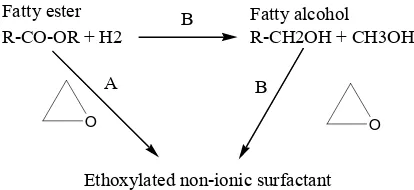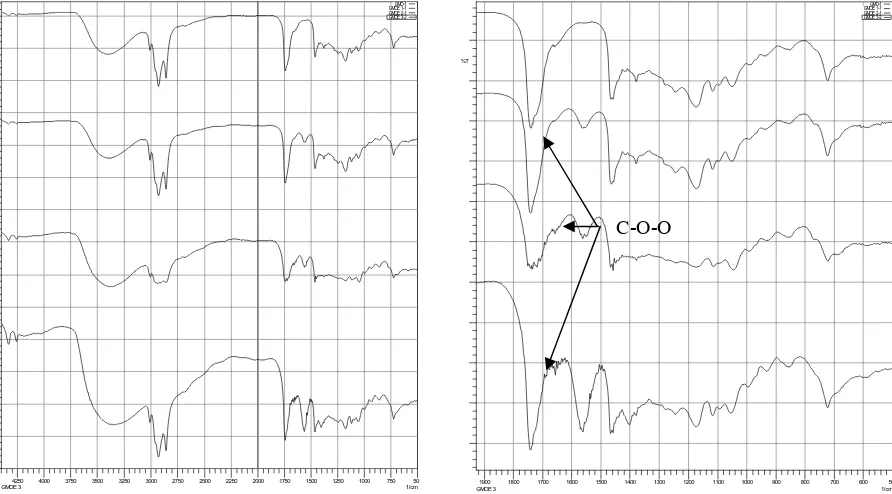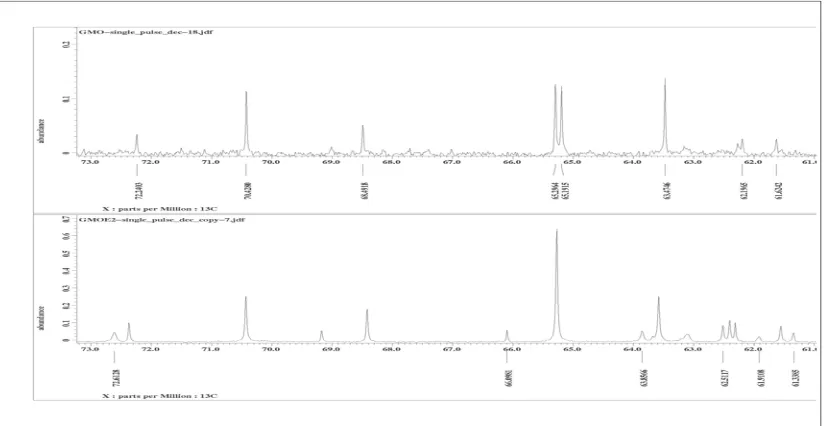DIRECT ETHOXYLATION OF GLYCEROL MONO OLEATE
FROM PALM OIL DERIVATE AS A NOVEL NON-IONIC
POLYMERIC SURFACTANT
Joddy Arya Laksmono
*), Indri Badria Adilina, dan Egi Agustian
The Research Centre for Chemistry – Indonesian Institute of Sciences
Kawasan Puspiptek Serpong, Tangerang, Indonesia 15314, Ph. +62 21 7560929, fax. +62 21 7560549
*)
Corresponding Author: joddy_arya_laksmono@yahoo.com
Abstract
The work investigates ethoxylation of glycerol mono oleate (GMO) performed in the presence of an alkaline catalyst. Glycerol mono oleate applied was derivated from Indonesian palm oil. The reaction was conducted with variation of Glycerol mono oleate : ethylene oxide ratio, temperature, and catalyst concentration. Forier Transform Infra Red (FTIR) and Nuclear Magnetic Resonance (NMR) analysis showed products with degrees of ethoxylation n=2 and n=3. FTIR analysis of products gave a new
peak at 1570 cm-1 supporting that C-O-C bond was formed. New peaks were also observed in 13-
C-NMR analysis of run 2 and run 3 with chemical shift of (δ) 61.3385; 61.9108; 62.5117; 63.8566;
66.0982; 72.6127 and 61.2172; 63.2393; 65.9100; 72.5201, respectively. Glycerol mono oleate ethoxylated was yielded and could be useful for a novel non-ionic polymeric surfactant.
Keywords:ethoxylation, glycerol mono oleate, Indonesian palm oil, non-ionic polymeric surfactant
Abstrak
Pada penelitian ini dilakukan proses etoksilasi gliserol mono oleat menggunakan katalis alkali. Gliserol mono oleat didapat dengan melakukan derivatisasi dari minyak sawit. Reaksi dilangsungkan dengan melakukan beberapa variasi perbandingan gliserol mono oleat : etilen oksida, temperatur, dan konsentrasi katalis. Berdasarkan analisa Forier Transform Infra Red (FTIR) and Nuclear Magnetic Resonance (NMR) didapatkan derajat etoksilasi n=2 dan n=3. Analisa FTIR memberikan puncak baru
pada 1570 cm-1 yang menandakan bahwa terjadi pembentukkan ikatan C-O-C. Puncak baru juga
terbentuk dari hasil analisa menggunakan 13-C-NMR pada proses run 2 dan 3, dengan pergeseran
kimia (δ) 61,3385; 61,9108; 62,5117; 63,8566; 66,0982; 72,6127 and 61,2172; 63,2393; 65,9100;
72,5201, secara berurutan. Dengan demikian, gliserol mono oleat etoksilat telah terbentuk dan dapat
digunakan sebagai polimerik surfaktan non-ionik varian baru.l non-ionic polymeric surfactant.
Kata kunci: ethoxylation, glycerol mono oleate, minyak sawit Indonesia, non-ionic polymeric
surfactant
INTRODUCTION
Surface-active agents (surfactants) are used in almost any household and personal care product as well industrial process, they can acts as a detergent, emulsifier or dispersants in colloidal systems. Directly ethoxylated fatty acid methyl esters are emerging on the markets as surfactants. Taking into account the reduced production cycle of fatty acid methyl esters compred with fatty alcohols, significant cost reduction could be expected (Hreczuch, 2002).
With the advanced development of oleochemistry, surfactants from palm oil is currently an interesting issue to be investigated. Ethoxylation as one of the polymeric nonionic surfactants are produced in industry by reacting ethylene oxide with an organic
molecule containing mobile hydrogen such as fatty alcohols, alkyl phenols, or fatty acids (Di Serio et al, 1994).
R-CO-OR + H2 R-CH2OH + CH3OH
Ethoxylated non-ionic surfactant
O O
B
B A
Fatty ester Fatty alcohol
The general mechanism for ethylene oxide addition to fatty methyl ester has been described, stating that the added molecule is inserted selectively between the carbonyl carbon and methoxy group at the ester bond (Hama et al, 1997). Di Serio et al conducted ethoxylation in the liquid phase, at 150-180ºC and 2-5 atm, in the presence of an alkaline catalyst.
Ethoxylation produces polymeric surfactants which lengthens the hydrophilic part of the surfactant. Polymeric surfactants serve all the same functions as normal surfactants, the main difference being their greater molecular mass and higher order structural conformation. Polymeric surfactants adsorb at surfaces, either of solids to give enhanced colloidal stability, or of liquids to control foaming or emulsion stability. The choice of monomer will normally depend upon the properties required for the polymeric surfactant. Therefore, an oil soluble surfactant which stabilises an aqueous dispersed phase in an oil may be prepared by grafting hydrophobic monomers onto a water soluble substrate. For the reverse system, a water-soluble surfactant which stabilises an oil phase in water can be made by grafting hydrophilic monomers on to a hydrophobic substrate (Singh, 2006).
Surfactants are amphiphatic molecules which have a hydrophilic and hydrophobic part. Both parts have strong influence on their properties and ability to sustain stability. In this research, synthesis of polymeric surfactant was performed by direct ethoxylation, reacting ethylene oxide with glycerol mono oleate as a glyceril ester. The glycerol mono oleate were derivered from palm oil in the prescence of an alkaline catalyst. Analysis will be conducted using Fourier Transform Infrared (FTIR) and Nuclear Magnetic Resonance (NMR).
EXPERIMENTAL METHOD Materials
Fatty acid of palm oil (PT. Sumiasih, Indonesia), ethylene oxide (Sigma Aldrich, Singapore), and potassium hydroxide (E Merck) were used in the experiments. Nitrogen gas was supplied from BOC gases.
Method
Ethoxylation of glycerol mono oleate
Ethoxylation was conducted in a 600 mL bubble column reactor. The synthesis was performed at 120-180ºC, with variation of KOH concentration. The reagent molar ratio and reaction time was kept constant at ethylene oxide: glycerol mono oleate = 1:1 and 5 hours. The reactor was flowed with nitrogen gas to avoid the presence of air and excess of oxygen. Glycerol mono oleate (1 mol) was then placed in the column and ethylene oxide (1 mol) was flowed into the reactor. The pressure was recorded and the reaction was performed for 5 hours. Product was collected and analyzed.
Fourier Transform Infrared (FTIR) analysis
The product was then analyzed by Fourier Transform Infrared (FTIR) spectroscopy (Shimadzu IRPrestidge-21/FTIR-8000) transmittance sampling technique. Samples were measured with spacer of 0.01 mm ~ 0.02 mm thickness on a KBR cell plate and then placed in the sample holder. Apodization was performed by Happ-Genzel method with number of scans: 45, resolution: 4.0 and wavelength range: 500 – 4000 cm-1.
Nuclear Magnetic Resonance (NMR)
Nuclear Magnetic Resonance (JEOL, 500 MHz) analysis was also performed to for structure identification. An amount of the product samples were dissolved in CDCl3 and placed in the sample
holder. Proton (1H), carbon (13-C) analysis was measured. Glycerol mono oleate as the starting material was also analyzed and compared towards data of the ethoxylation products.
RESULT AND DISCUSSION
Ethoxylation of glycerol mono oleate (GMO) was recorded in Table 1. The reaction was kept constant for 5 hours with the same molar ratio. Run 1 was performed at 120ºC, KOH 1%, run 2 at 180ºC, KOH 1%, and run 3 at 180ºC, KOH 5%.
Table 1 shows the density and viscosity of the glyceril products. The density increased with the increase of temperature. This indicates that the ethoxylation occurred with the increase of molecular weight. The highest was recorded at run 3 with 0.9684 g/cm3. The level of viscosity was also increased with the increase of pressure and catalyst concentration. It can be seen that GE with viscosity of 67.04 cp increased after ethoxylation and the product gave viscosity of 76.59 cp, 88.16 cp, and 253.64 cp.
Acid and ester value of GE ethoxylate can be observed in Figure 2. It can be seen that a decrease of acid value occurs from run 1 to run 3. The decrease was due to the presence of KOH in the reactor. The free fatty acid in the starting GE reacts with KOH yielding a metal salt and saponification. It was also caused by the increase of reaction temperature. At run 1 and 2, an amount of 1% of KOH was used and yielded 22.94 and 19.5 of acid value. Meanwhile at run 3 where 5% KOH was applied, a drop of acid value as much as 12.35 was observed.
Table 1. Density and viscosity of GMO and product of ethoxylation
Run Time (h) Temperature (ºC) GMO:EO (mol) Catalyst (%) ρ (40°C) η (40°C) GMO - - - - 0.9392 g/cm3 67.04 cp 1 5 120 1: 1 1 0.9418 g/cm3 76.59 cp 2 5 180 1: 1 1 0.9464 g/cm3 88.16 cp 3 5 180 1: 1 5 0.9684 g/cm3 253.64 cp
0 20 40 60 80 100 120 140
1 2 3
Ru
n
Value acid value
ester value
Figure 2. Acid value and ester value of glyceril mono oleate ethoxylated products
500 750 1000 1250 1500 1750 2000 2250 2500 2750 3000 3250 3500 3750 4000 4250
1/cm %T
GMO-1 GMOE 1-1 GMOE 2-1 GMOE 3-2
GMOE 3 1900 1800 1700 1600 1500 1400 1300 1200 1100 1000 900 800 700 600 1/cm500 %T
GMO-1 GMOE 1-1 GMOE 2-1 GMOE 3-2
GMOE 3
C-O-O
Fourier Transform Infrared (FTIR) analysis was performed to see the changes in functional groups of the starting material and product. It can be observed in fig. 3 that a new peak was formed at 1570 cm-1. This peak indicated the C-O-O binding which was formed due to ethoxylation. At run 1 the intensity was quite weak, but at run 2 and 3 increase of intensity occurred indicating that the ethoxylation was greater. This is not seen in the starting material. Further analysis of the products was performed by C-NMR analysis.
The degree of polymerization was determined by
13
C- Nuclear Magnetic Resonance (13C-NMR). The addition of two carbon atoms in the structure indicates
that one ethylene oxide molecule was inserted between the carbonyl group in the glycerol mono oleate structure. The result of analysis is shown in Figure 4.
Figure 4 shows the overlay of C-NMR analysis of glycerol mono oleate and run 2. Six new peaks were observed with chemical shifts (δ) 61.3385; 61.9108; 62.5117; 63.8566; 66.0982; and 72.6127. This indicates that three molecules of ethylene oxide was inserted in the structure and yielded product with degree of polymerization n=3.
The analysis of run 3 is given in Figure 5. New peaks were also observed with chemical shifts (δ) 61.2172; 63.2393; 65.9100; and 72.5201. The degree of polymerization was slightly lower in run 3 with n=2. At run 1, there were no significant changes therefore the result was not given. It can be predicted that the ethoxylation occurred but not as much in run 2 and run 3.
CONCLUSION
Ethoxylation of glycerol mono oleate from palm oil can undergo in a bubble column reactor at temperature 120-180ºC, 5 hours, and molar ratio GE: EO = 1:1. The products had higher level of density and viscosity than that of the starting material glycerol mono oleate. The structure was predicted by FTIR analysis with the formation of C-O-O functional group at 1570 cm-1. The degree of polymerization differed with the ethoxylation condition identified by 13C-NMR analysis. In this research an ethoxylate product with degree of polymerization n=2 and n=3 was yielded.
REFERENCES
Breindel, K., Broadbent, Ronald, W., Wiggins, Michael, S., Natele, and Marcie, (2001), Branced polymeric surfactant reaction products, methods for preparation and use therefore, USP20010027227. Di Serio, Di Martino, S., and Santecesaria, E., (1994), Kinetics of fatty acids polyethoxylation, Ind.
Eng. Chem. Res, 33, 509-514
Di Serio, M., Vairo, G., Lenggo, P., Fillipone, F., and Santacesaria, E., (1996), Kinetics of ethoxylation and propoxylation of 1- and 2-octanol catalyzed by KOH,
Ind. Eng. Chem. Res., 35, 3848.
Hama, I., Okamoto, T., Hidai, E., and Yamada, K., (1997), Direct ethoxylation of fatty methyl ester over Al-Mg composite oxide catalyst, JAOCS, vol. 74, no.1
Hreczuch, W., (2002), Temperature-related reaction kinetics and product composition of ethoxylated fatty acid methyl esters, J. Chem. Technol. Biotechnol, 77: 511-516.
Singh, M., (2006), Polymeric surfactant,


